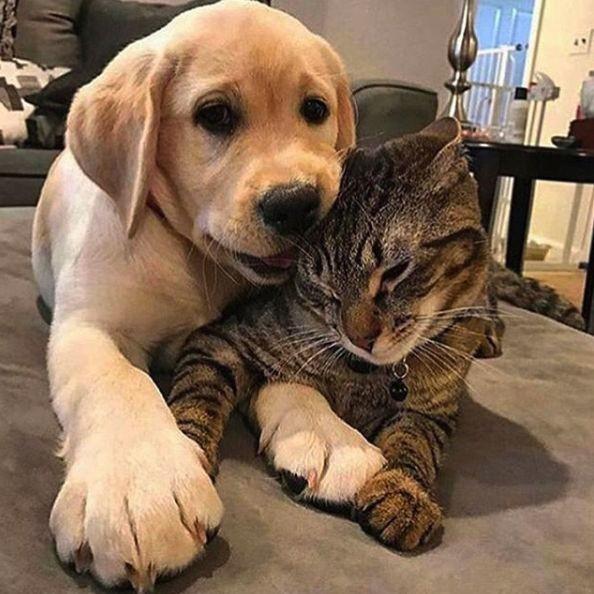Key Takeaways
-
Understanding your Labrador’s temperament is crucial for a successful introduction to a cat.
-
Prepare your home by creating separate spaces and using scent swapping to familiarize your pets with each other.
-
Introduce your Labrador to your cat slowly, with controlled meetings and close supervision.
-
Interpret pet body language to gauge their comfort levels and adjust the introduction process accordingly.
-
If signs of stress or aggression appear, it’s important to separate the pets and slow down the introduction, or seek professional help.
Understanding Your Labrador’s Temperament
First things first, let’s chat about your Labrador’s personality. Just like us, dogs have their quirks. Some Labs are laid-back couch potatoes, while others are curious explorers with enough energy to run a marathon. Knowing which category your rescue dog falls into will help you tailor the introduction to their style. A mellow Lab might need just a simple and calm introduction, but an energetic one? That’s a different ball game. They’ll need more structured and careful introductions to avoid overwhelming your cat.
It’s also key to remember that rescue dogs may have past experiences that shape their behavior. If your Lab has lived with cats before, you might have a smoother ride. If not, or if you’re unsure, prepare for patience. It’s like baking a cake from scratch – you’ll need the right ingredients and time for everything to come together perfectly.

“This Cute Yellow Labrador Retriever Pup …” from www.reddit.com and used with no modifications.
Preparing Your Home for a Safe. Introduction
Before we get to the nose-to-nose meeting, let’s set the stage at home. You wouldn’t throw a party without tidying up first, right? Same goes for introducing your pets. You want a clean, safe, and neutral space.
-
Start with scent swapping. Give your Lab a blanket that your cat has slept on, and vice versa. It’s like getting a sneak peek at someone’s profile before you meet them – it helps make the first meeting less of a shock.
-
Next, carve out separate areas for each pet. This gives them their own turf and keeps the peace. Think of it as setting up base camps before they venture into shared territory.
-
Lastly, make sure you have all the supplies you need – treats, leashes, and maybe even a baby gate. These are your tools to guide the introduction, kind of like having a good map on a road trip.
And remember, always have an exit strategy. If things get too heated, you’ll want to be able to separate your pets quickly and safely.
Pre-Introduction Strategies
Now, let’s talk about what to do before your Lab and cat even lay eyes on each other. You wouldn’t run a marathon without training, and the same goes for pet introductions. Let’s get them ready.
Setting the Stage: Safety Measures
Before the big introduction, take some safety measures. Think of it like putting on your seatbelt before driving.
First, ensure your Lab is well-exercised. A tired dog is a calm dog, and you want them as relaxed as possible. It’s like taking the edge off before a big exam.
Next, have a leash and treats handy. You’ll use these to keep your Lab under control and reward good behavior. It’s about positive reinforcement, like getting a gold star in class for a job well done.
Separate But Equal: Establishing Personal Spaces
Both your Lab and your cat need their own “rooms” to start. This isn’t about playing favorites; it’s about giving each pet a safe haven. For your cat, set up a high perch or a separate room. Cats like to survey their kingdom from above.
For your Lab, a comfy bed and some toys in a designated area will do the trick. This is their chill zone, where they can relax and feel secure. And make sure each pet has their own food and water bowls – sharing isn’t always caring in the animal world.
By setting up these personal spaces, you’re giving your pets a sense of security. It’s like having a cozy bedroom to retreat to after a long day.
Reading the Room: Interpreting Pet Body Language
When the time comes to finally introduce your Labrador to your cat, body language is like their personal chat. It’s how they say “hello” or “back off” without making a sound. You’ll want to be fluent in their non-verbal cues to make sure the conversation goes smoothly.
Watch your Lab’s tail wagging. Is it relaxed and low or stiff and high? The former is like a friendly wave, while the latter is more like a hand on a hip. And your cat? If they’re swishing their tail or their ears are pinned back, they’re probably not in the mood for making friends. It’s like checking the weather before you head out – you want to know what you’re walking into.
Post-Introduction: Building a Bond
So, you’ve made the introductions, and it’s gone well. What now? Time to build that bond. Think of it as nurturing a new friendship – it takes time and shared experiences.
Fostering Friendship Through Feeding
Food is a great peacemaker. Try feeding your pets at the same time, but with a safe barrier between them. It’s like having dinner with a neighbor, but with a fence for comfort. This way, they associate each other’s presence with something positive – yummy food!
Shared Playtime and Positive Associations
Shared activities can also help. Engage in playtime where both pets can participate at a comfortable distance. It’s like joint activities at camp – they’re fun and can turn strangers into buddies.
For example, if your Lab loves to fetch (and most do), throw the ball in a way that brings them back past the cat’s space, but not too close. The cat gets used to their presence without feeling threatened.
And don’t forget the treats! Rewarding both pets when they behave calmly around each other reinforces good behavior. It’s like giving kids stickers for sharing nicely.
When Things Don’t Go As Planned
Sometimes, despite your best efforts, things can go sideways. It’s like planning a picnic and then it rains. You need a backup plan.
If your Lab gets too excited or your cat seems stressed, separate them immediately. It’s not a setback; it’s just a sign to take things slower. Remember, slow and steady wins the race.
Signs of Stress and Steps to Take
Keep an eye out for signs of stress. Is your Lab panting or pacing? Is your cat hiding or hissing? These are red flags, like a check engine light in your car.
Here’s what to do:
-
Give them a break. Separate them and let them cool down. It’s like hitting the pause button on a heated game.
-
Go back to scent swapping or feeding on opposite sides of a door. It’s a way to keep the peace while still keeping them aware of each other.
-
Try shorter, more controlled introductions next time. It’s like taking baby steps instead of jumping in with both feet.
Professional Guidance: When to Seek Help
If things aren’t improving, it’s okay to call in the pros. A behaviorist is like a tutor for your pets, giving them the extra help they need to get along. They can provide tailored advice and strategies to make the introduction process smoother.
And remember, there’s no shame in asking for help. It’s about giving your pets the best chance to live happily together.
The Happy Outcome: Living Together in Harmony
When all goes well, your Lab and cat can coexist in harmony. It’s like a well-orchestrated duet, each knowing their part and when to chime in.
But don’t expect them to be best friends overnight. It’s a process, like building a friendship over time. They’ll need to learn each other’s likes and dislikes, and how to share their space.
Most importantly, keep an eye on their interactions. Just because they’re doing well now doesn’t mean they don’t need supervision. It’s like being a lifeguard – always on duty, even when the waters seem calm.
Everyday Life: A Blended Pet Family
As time goes on, you’ll start to see the fruits of your labor. Your Lab and cat may start to play together, or simply coexist peacefully. It’s like watching a plant grow – you water it, give it sunlight, and gradually, it blooms.
But remember, every pet is different. Some may become inseparable, while others prefer a respectful distance. And that’s okay. It’s about finding a balance that works for everyone in your blended pet family.
So, take it one day at a time, celebrate the small victories, and enjoy the journey of bringing your furry friends together. It’s a rewarding experience that can bring so much joy to your home.
Monitoring Interactions and Adjusting as Needed
Once your Labrador and cat are introduced, it’s vital to keep a watchful eye on their interactions. Think of yourself as a referee in a friendly game – you want to ensure fair play and intervene if things get out of hand. Here’s what to keep in mind:
-
Watch for signs of aggression or fear. If either pet seems uncomfortable, it’s time to step in and give them a break from each other.
-
Continue to supervise their time together until you’re confident they can interact safely. It’s like teaching kids to swim – you don’t leave them unsupervised until you’re sure they can handle it.
-
Gradually increase their shared time as they become more comfortable with one another. It’s like slowly turning up the heat on the stove – too fast, and things might boil over.
Remember, every pet has its own personality and pace for making friends. Some might hit it off right away, while others take time to warm up to each other. The key is patience and careful observation.
Frequently Asked Questions (FAQ)
How long should I wait before introducing my Labrador rescue dog to my cat?
Wait until your new Labrador feels comfortable in your home, which could take a few days to a few weeks. Give your Lab time to get used to their new environment, and use that time to exchange scents between your pets. If it is possible for them to meet on neutral turf, that may make things easier. Many adoption agencies allow potential adopters have their pets meet in advance to test the waters.
What should I do if my rescue dog shows aggressiveness towards the cat?
If your Labrador shows any signs of aggression, like growling or lunging, it’s crucial to separate them immediately. It’s like hitting the brakes when you see a red light – it’s for everyone’s safety. Afterward, go back a few steps in the introduction process, and consider consulting a professional trainer or behaviorist.
Can an adopted Labradors get along with my existing cats even if they didn’t grow up together?
Yes, many adopted Labradors can learn to get along with cats, even if they weren’t raised with them. It’s like learning a new language – with the right approach and plenty of practice, they can become fluent in living together peacefully.
How can I tell if my cat is stressed by the presence of a new dog?
Stressed cats may hide more, hiss, swat, or avoid the dog altogether. They might also change their eating or litter box habits. It’s like someone pacing during a stressful phone call – it’s a sign they’re not comfortable.
Are there specific breeds of cats that get along better with dogs?
While it’s more about individual personalities than breeds, some cat breeds are known for being more dog-friendly, like Maine Coons and Ragdolls. Think of them as the social butterflies of the cat world – they tend to be more relaxed around other animals, including dogs.


